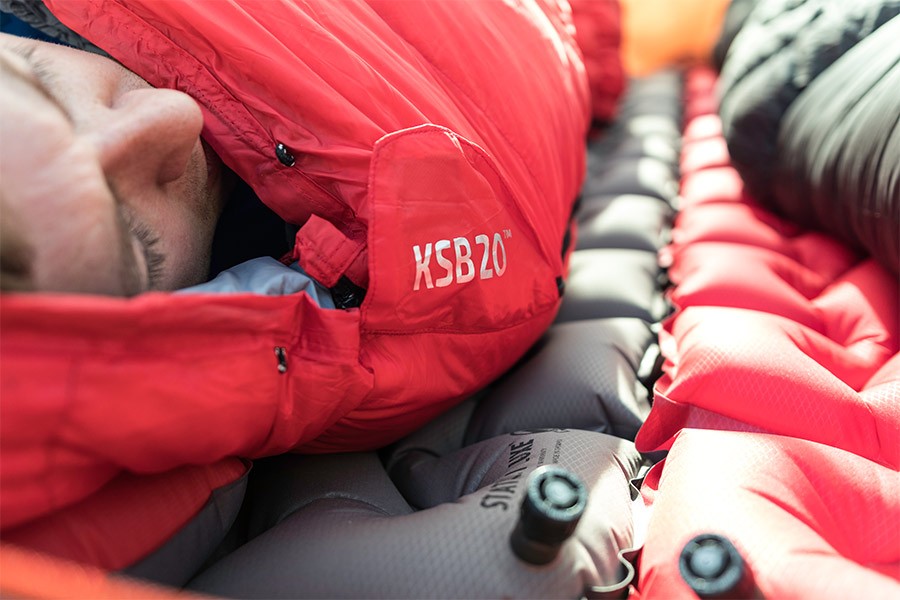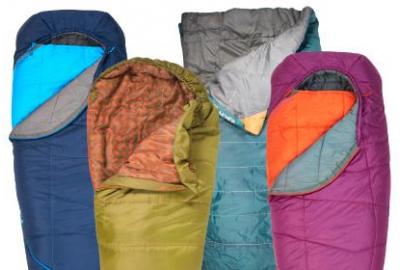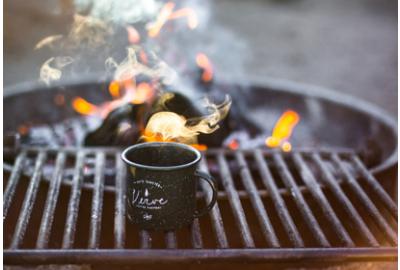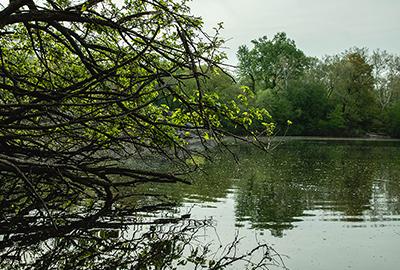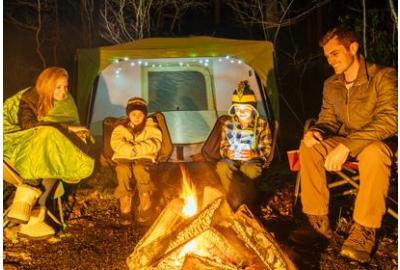With so many options for sleeping bags out there, it can be a daunting task to pick the one that is right for YOU. We’ve compiled all the information you need to select one that covers your needs and gives you the best sleep.
Shape
Start with the shape. The two main shapes for sleeping bags are mummy and rectangular, although different brands have some of their own unique shapes (like Kelty has a mummy-style sleeping bag designed to grow with your youth and some brands have semi-rectangular, for example). Remember, the key goal for a sleeping bag is to trap in your body heat to keep you warm. So the colder the climate, the slimmer fit you should aim for with shape!
Rectangular/Square
- Great for beginners
- Ideal for family or car camping
- Good option for warmer climates
- Lots of room for rolling around
- Can be unzipped and used as a blanket
- Can be used as an extra sleeping pad (unzipped or left as-is)
- Tends to be more budget-friendly
- Doesn’t hold heat as efficiently
- Can be a bit bulky for backpack camping
- Also tends to be heavier (because there is more material!)
Mummy
- Great for backpack and high-altitude camping
- Better for cooler/cold/freezing temperatures (very efficient)
- Keeps your head warm with the insulated hood (because the head is where you lose the most body heat!)
- Lighter weight
- Rolls into a smaller bundle
- Can feel restricting
- Typically runs at a higher price point
- Not as great for warmer temperatures
Fill
There are two types of fill or insulation for sleeping bags: down and synthetic. The down feather structure traps air well and provides lots of warmth.
Down
Fill Power measures how many cubic inches of loft one ounce of down fill produces. The higher the fill power, the greater the loft and insulating efficiency. Think of it this way: the fluffier the down, the warmer the insulation (because there is more space for those little air pockets).
- Provides the most warmth for the least amount of weight
- Has a long “life span” when taken care of properly
- Can roll up tighter and smaller
- Great for backpack camping
- Not the best for wet conditions – down takes longer to dry
- Higher price point
- More maintenance required
Synthetic
In sleeping bags that use synthetic insulation, the synthetic material attempts to “copy” the down fibers. The fibers are made to hold space between them to trap air like the down fibers do.
- Great for wet conditions
- Holds heat even when wet
- Easier to care for (can be machine washed and dried!)
- Easier on allergies
- Heavier and less efficient than down (to achieve the same amount of warmth)
- Less longevity than down
- Not as compressible as down
Temperature Ratings
Sleeping bags are rated using both EN (European Norm) standard (this was the original standard adopted by the industry) and now, testing is overseen by the ISO (International Standards Organization). The ISO uses basically the same methods for testing as the EN testing, so you can compare them like they are apples-to-apples.
- Rating: This is the temperature that is listed on men’s bags, and it is where a man OR a warm sleeper would be comfortable (no chills) in underlayers (because generally and physiologically speaking, women tend to run a bit more “cold” than men, and tend to be a little more sensitive to the cold than men). If you are a cold sleeper, you can add more layers or a liner to your bag and it would bring this up to where you would be comfortable (15°-20° higher than the rating listed).
- Comfort Rating: This is the temperature that is estimated where cold sleepers would actually be comfortable sleeping in. This is the rating most commonly shown on women’s bags and is higher than the regular rating and lower limit/risk rating. So, if a women’s bag shows that it is a “30° Bag”, that means that a colder sleeper would be decently warm (no goosebumps) in underlayers.
- Lower Limit/Risk Rating: This is always lower than the regular rating and the comfort rating and is the estimated temperature at which warm sleepers might still be comfortable. If you are generally a hot sleeper, this would be more like your temperature to go off of, although keep in mind that this is also the lowest temperature that would be “safe” (more specifically looking at freezing temperatures).
Also keep in mind that these are assuming that your bag is not resting directly on the ground. Sleeping pads and insulated sleeping pads will help both add warmth and keep warmth from being leached out by the ground.
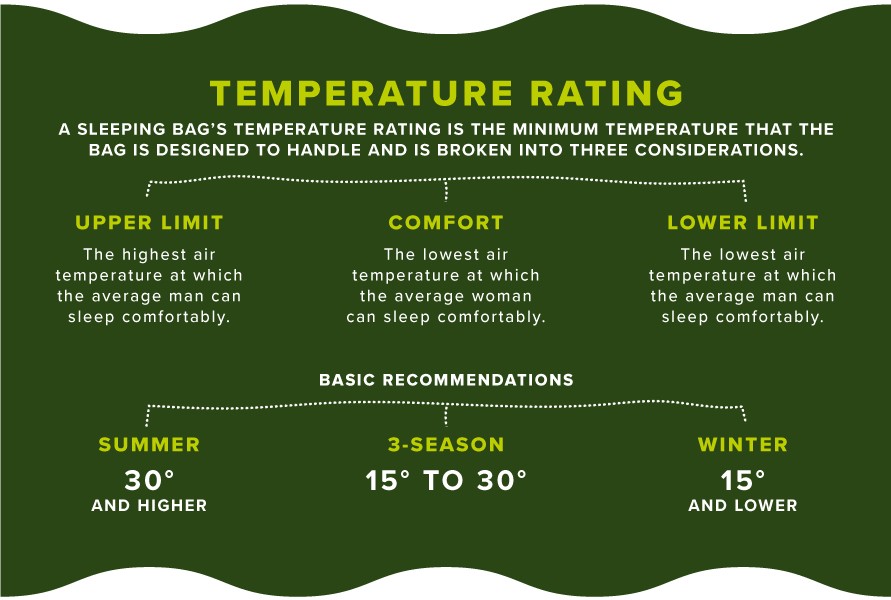

Women’s vs Men’s
As mentioned above under temperature ratings, women’s and men’s bags differ both in how temperature ratings are listed AND how they are fitted/sized.
Women’s
- Slimmer and more streamlined
- Sewn differently so that the insulation is trapped differently
- Uses comfort ratings
Men’s
- More roomy
- Uses ratings that are a little cooler than comfort ratings
Kid’s
- Adjustable length that allows you to “shorten” it to keep heat in close
Storage and Care
First and foremost, it is best to follow the instructions that come with your sleeping bag when looking to clean it!
- To ensure the longest life span possible for your sleeping bag, store laid flat versus keeping it compressed.
- As mentioned earlier, most synthetic bags can be washed in the washing machine and dried in the dryer (although keep in mind that the more you do that, the shorter the life of your bag!). When drying your bag, add a tennis ball or wool dryer balls to help beat around and re-distribute the fill.
- To launder/clean a down bag, grab a down cleaner and hand wash in a bathtub.
Some Additional Pro Tips
- If you are a cold sleeper or are sleeping in a cold environment, eat before you go to bed (as you digest, you will create more body heat)
- Again, if you are a cold sleeper or need to create some additional body heat, do some jumping jacks right before you go to bed or some bicycles twists inside of your sleeping bag to generate more heat for your bag to trap
- If you know you are heading on a wet adventure, pack your sleeping bag in a waterproof bag (either a 5L or 10L, depending on your sleeping bags size) to make sure it stays nice and dry!
To Recap
If you are heading out into a warmer environment, rectangular and synthetic bags (or even simply a bag liner!) work well. If you are heading into cold weather, mummy and down bags are your best choices.
Sleeping bags (especially down!) are an investment and are meant to last years! Wearing socks underlayers, and using sleeping bag liners will help keep your bag staying fresh between washes.
Have your own tips for picking out the perfect bag? Drop them in the comments for your fellow Scouts! And as always, share your campout pictures with us on social for your chance to be featured on our Instagram or on Scoutshop.org (just tag us using #ScoutShopBSA).
